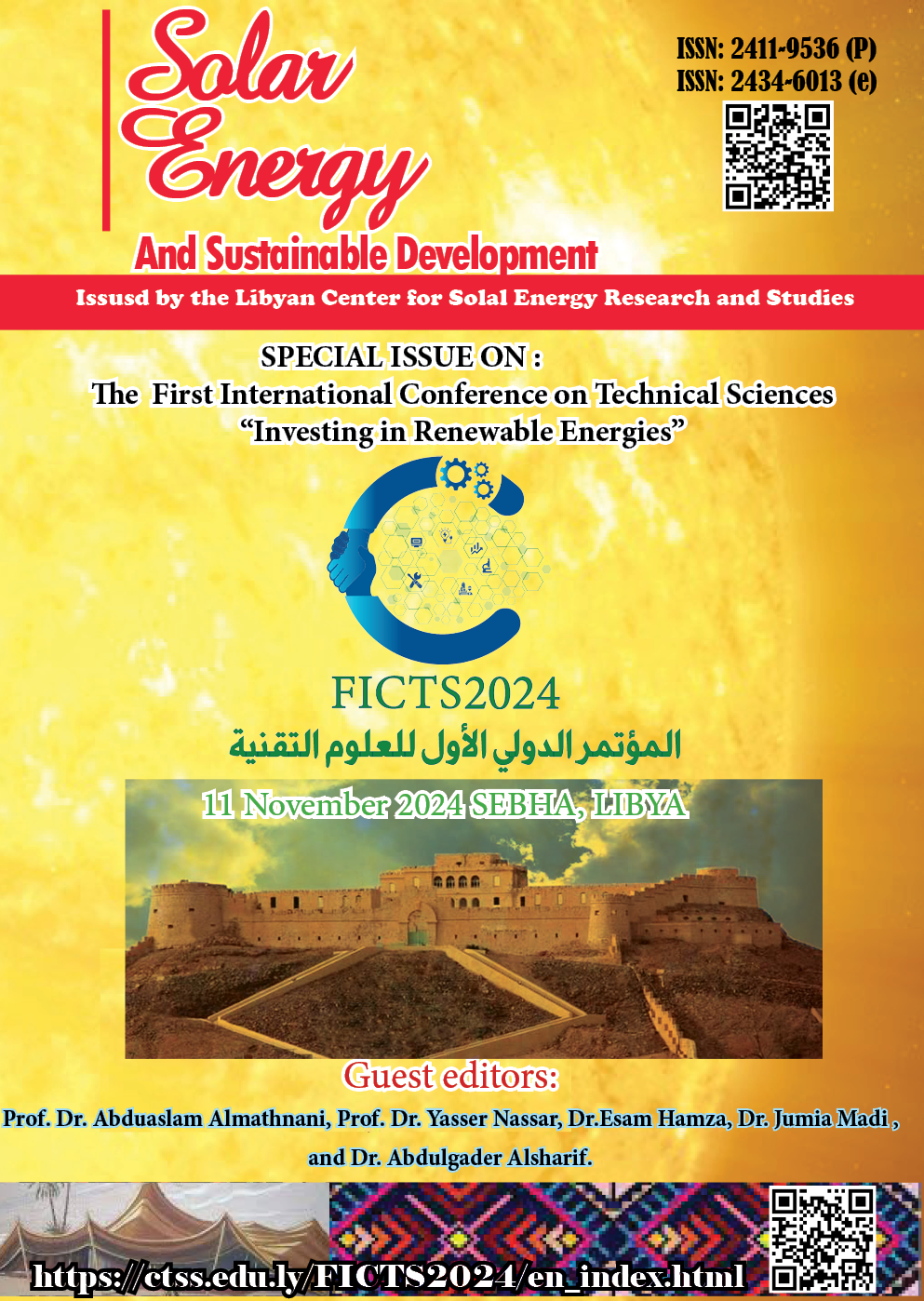Geothermal Energy Utilization of Co-Production Water from Oilfields for Electric Power Generation
DOI:
https://doi.org/10.51646/jsesd.v14iFICTS-2024.445Keywords:
Geothermal energy, oilfields, co-production, temperature, power generation, power plant.Abstract
One significant source of geothermal energy is the co-produced hot water from oil/gas field production. There is potential to utilize oilfield infrastructure to produce geothermal electricity profitably, in a process called co-production. Due to the increasing demands of energy now days, this paper presents an investigation of geothermal energy production and utilization for electricity generation on the petroleum fields via organic Rankine cycle (ORC) technology, which is a reliable way to convert heat into electricity. The current research focuses on the use of an ORC unit to generate electricity from co-produced water from ten oil wells in two oilfields, Jalo and Sarir. These wells refer to GX1, GX2, Gx3, GX4, GX5, SX1, SX2, SX3, SX4, and SX5, and they are combined in gathering centers (GC1) and (SC2) to utilize an existing medium-temperature geothermal source. The estimated total flow rates of co-produced water from the two gathering centers after separation are 5,728.34 BWPD and 14,618.65 BWPD respectively. Whereas, the geofluid mass flow rates from both oilfields are 12.25 kg/s and 34.05 kg/s, respectively, with an inlet geofluid (brine) temperature (T1) of 60°C and an outlet geofluid temperature (T2) of 35°C. The thermal efficiency (ηth) values for the Jalo and Sarir oilfields are 3.28% and 4.22%, respectively. According to the power output analysis, which indicates that the specific power outputs are 5.17 kW/kg/s and 9.85 kW/kg/s, and the gross power outputs are 63.33 kW and 338.80 kW, respectively, with a required hot water flow rate of 12.25 kg/s and 34.05 kg/s. This study revealed that the temperature and water flow rate are crucial factors affecting power output. By using an ORC plant, the generated electric power can be used in the field, supplied to the local grid, or utilized to offset on-field electricity consumption. Also, this study recommended by focusing efforts to extract the energy through electric power generation via production oil wells in oilfields.
Downloads
Metrics
References
Dal Ferro, B. and Smith, M. (2007) Global Onshore and Offshore Water Production, http://www.touchoilandgas.com/global-onshore-offshore-water-a7137-1.html.
Khatib, Z. and Verbeek, P., (2003) “Water to Value – Produced Water Management for Sustainable Field Development of Mature and Green Fields,” Journal of Petroleum Technology, 26-28. DOI: https://doi.org/10.2118/0103-0026-JPT
Patel, Chirag V. (2004) “Effective Management of Produced Water,” MS thesis, Department of Petroleum Engineering, Texas A&M University, College Station.
Clark, C. E. and Veil, J. A., (2009) “Produced water volumes and management practices in the United States. http ://www.ipd.anl.gov/anlpubs/2009/07/64622pdf DOI: https://doi.org/10.2172/1007397
Think Geoenergy, (2018) Five Geothermal Projects Under Renewable Funding Program, Netherland. Retrieved July 3, 2018, from: http://www.thinkgeoenergy.com/five-geothermal-projects-under-renewable-energy-funding-program-netherlands/
Younger, P.L. (2015). Geothermal Energy: Delivering on the Global Potential. Basel:MDPI AG. DOI: https://doi.org/10.3390/en81011737
Jon G., Alison A., Charlotte A., Catherine Hi., Simon H. and Jonathan C. (2019) Geothermal Potential of the Global Oil Industry. in Renewable geothermal energy explorations. , pp1-1.
https://doi.org/10.5772/intechopen.81062 DOI: https://doi.org/10.5772/intechopen.81062
Arabian Gulf Oil Company (AGCO), (2019) Sarir Field Data base and History File.
DiPippo, R. (2004) “Second Law Assessment of Binary Plants for Power Generation from Low Temperature Geothermal Fluids,” Geothermics, V. 33, pp. 565586. DOI: https://doi.org/10.1016/j.geothermics.2003.10.003
Zhang, L., Yuan, J., Liang, H., Li, K. (2008) Energy from Abandoned Oil and Gas Reservoirs, Proceedings, Asia Pacific Oil and Gas Conference and Exhibition, Perth, Australia. DOI: https://doi.org/10.2118/115055-MS
Davis, A.P., and Michaelides, E.E. (2009) Geothermal power production from abandoned oil wells, Energy, 34. DOI: https://doi.org/10.1016/j.energy.2009.03.017
Bu, X., Ma, W., Li, H. (2012) Geothermal energy production utilizing abandoned oil and gas wells, Renewable Energy, 41. DOI: https://doi.org/10.1016/j.renene.2011.10.009
Barbacki, A.P. (2000) The use of abandoned oil and gas wells in Poland for recovering geothermal heat, Proceedings, World Geothermal Congress, Kyushu – Tohoku, Japan.
Sanyal, S., Bulter, S. (2010) Geothermal Power Capacity for Petroleum Wells-Some Case Histories of Assessment, Proceedings, World Geothermal Congress, Bali, Indonesia.
Xin, S., Liang, H., Hu, B., & Li, K. (2012). Electrical Power Generation from Low Temperature Co-produced Geothermal Resources at Huabei Oilfield. Thrity-Seventh Workshop on Geothermal Reservoir Engineering Stanford University. Stanford.
Cheng, W.L., Li, T.T., Nian, Y.L., Wang, C.L. (2013) Studies on geothermal power generation using abandoned oilwells, Energy 59. DOI: https://doi.org/10.1016/j.energy.2013.07.008
Riney, T.D. (1991) Pleasant Bayou Geopressurised Geothermal Reservoir Analysis, Centre for Energy Studies, University of Texas, Austin. DOI: https://doi.org/10.2172/893428
Bennett, K, Li, K and Horne, R.: (2012) “Power Generation Potential from Coproduced Fluids in the Los Angeles Basin,” Proceedings of Thirty-Seventh Workshop on Geothermal Reservoir Engineering Stanford University, Stanford, California, February 1-3.
Singh, H.; Falcone, G.; Volle, A.; Guillon, L. (2017) Harnessing Geothermal Energy from Mature Onshore Oil Fields-The Wytch Farm Case Study. Work. Geotherm. Reserv. Eng., 17,
https://eprints.gla.ac.uk/172301/.
Moya, D., Aldas, C., Kaparaju, P., (2018) Geothermal energy: power plant technology and direct heat applications. s.l. Renew. Sustain. Energy Rev. 94, 1364e0321. DOI: https://doi.org/10.1016/j.rser.2018.06.047
Vraa, H.; Picklo, M.; Hertz, E.; Gosnold, W. (2019) Geothermal Energy Utilization of Multi-Well Oil Pads via the Application Of Organic Rankine Cycle Systems. Trans. - Geotherm. Resour. Counc.., 43, 1078– 1084
Banks, J.; Willems, C. J.; Cowper, A.; Nadkarni, K.; Poulette, S.; Van Allen, C. (2021) Geothermal Power Potential of the Virginia Hills Oil Field, Part of the Swan Hills Carbonate Complex. Proceedings World Geothermal Congress, Alberta, Canada; https://pangea.stanford.edu/ERE/db/WGC/papers/WGC/2020/16050.pdf?t=1590520758.
Robins, J.C., Kolker, A., Flores-Espino, F., Pettitt, W., Schmidt, B., Beckers, K., others, Anderson, B., (2021) US Geothermal Power Production and District Heating Market Report. NREL. No. NREL/TP-5700-78291). DOI: https://doi.org/10.2172/1808679
McClure, M., Kang, C., Fowler, G., (2022) Optimization and design of next-generation geothermal systems created by multistage hydraulic fracturing. In: SPE Hydraulic Fracturing Technology Conference and Exhibition. https://doi.org/10.2118/ 209186-MS. D011S001R006. DOI: https://doi.org/10.2118/209186-MS
Mckittrick, A., (2023) Geothermal technologies office-FY23 mid-year update. https ://www.energy.gov/sites/default/files/2023-03/20230302_McKittrick_AASGMtg atDOE.pdf.
U.S. EIA, (2023) Monthly energy review. Monthly Energy Review, 0035(Junli) 1–278. www.eia.gov/mer.
IRENA, (2024) Renewable capacity statistics 2024. International Renewable Energy Agency, Abu Dhabi. www.irena.org.
Fatick Nath , Md Nahin Mahmood , Ebenezer Ofosu , Aaditya Khanal ; (2024) “Enhanced geothermal systems: A critical review of recent advancements and future potential for clean energy production” ; journal of Geoenergy Science and Engineering, Elsevier, Volume 243, December 2024, 213370. DOI: https://doi.org/10.1016/j.geoen.2024.213370
McKenna, J.R. and D.D. Blackwell (2005) “Geothermal Electric Power from Texas Hydrocarbon Fields,” GRC BULLETIN, May/June, pp. 121128.
DiPippo, R. (2005) Geothermal Power Plants : Principles, Applications and Case Studies, Elsevier Advanced Technology, Oxford, England.
Hettiarachchi, H. M., Golubovic, M., Worek, W. M., & Ikegami, Y. (2007). Optimum design critera for an Organic Rankine cycle using low-temperature geothermal heat sources. Energy, 1698-1706. DOI: https://doi.org/10.1016/j.energy.2007.01.005
Bahrami, M.(2018) -SFU-Canada: http://www.sfu.ca/~mbahrami/ENSC%20461/Notes/Vapor%20Power%20Cycles.pdf
Bilbow, W. M., Brasz, L.J. (2004) Ranking of Working Fluids for Organic Rankine Cycle Applications" (2004) International Refrigeration and Air Conditioning Conference. Paper 722.
Tester, J., Petty, S., Garnish, J., Batchelor, A., Drake, L., Veatch, R., et al. (2006). The Future of Geothermal Energy: Impact of Enhanced Geothermal Systems (EGS) on the United States in the 21st Century. Cambridge: Massachusetts Institute of Technology (MIT).
http://web.mit.edu/newsoffice/2007/geothermal.html.
Holmdann G. (2007). The Chena Hot Springs 400 kW Geothermal Power Plant : Experience Gained During The First Year of Operation. Geothermal Resources Council Transactions 31 : 515- 519.
Downloads
Published
How to Cite
Issue
Section
License
Copyright (c) 2025 Solar Energy and Sustainable Development Journal

This work is licensed under a Creative Commons Attribution-NonCommercial 4.0 International License.














